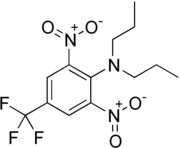
| |
| Names | |
|---|---|
| Preferred IUPAC name
2,6-Dinitro-N,N-dipropyl-4-(trifluoromethyl)aniline | |
| Other names
Treflan; α,α,α-trifluoro-2,6-dinitro-N,N-dipropyl-p-toluidine
| |
| Identifiers | |
3D model (JSmol)
|
|
| ChEBI | |
| ChEMBL | |
| ChemSpider | |
| ECHA InfoCard | 100.014.936 |
| KEGG | |
PubChem CID
|
|
| UNII | |
CompTox Dashboard (EPA)
|
|
| |
| |
| Properties | |
| C13H16F3N3O4 | |
| Molar mass | 335.283 g·mol−1 |
| Appearance | Yellow crystals |
| Density | 1360 kg/m3 [2] |
| Melting point | 46 to 47 °C (115 to 117 °F; 319 to 320 K) |
| Boiling point | 139 to 140 °C (282 to 284 °F; 412 to 413 K) (at 4.2 mmHg) |
| 0.0024 g/100 mL | |
| Solubility in acetone | >1000 g/L[2] |
| Hazards | |
| Occupational safety and health (OHS/OSH): | |
Main hazards
|
Toxic to aquatic life |
| Lethal dose or concentration (LD, LC): | |
LD50 (median dose)
|
>5000 mg/kg (rat, oral) |
Except where otherwise noted, data are given for materials in their standard state (at 25 °C [77 °F], 100 kPa).
| |
Trifluralin is a common pre-emergent selective herbicide, a dinitroaniline. With about 14 million pounds (6,400 t) used in the United States in 2001,[3] and 3–7 million pounds (1,400–3,200 t) in 2012,[4] it is one of the most widely used herbicides. Trifluralin is also used in Australia,[5] and New Zealand,[6] previously in the EU. Introduced in 1964, Trifluralin was the first organofluorine compound used as an agrochemical.[7]
Trifluralin is generally applied to the soil to control annual grass and broadleaf weed species. It inhibits root development by interrupting mitosis and controls weeds as they germinate.[5][8] Trifluralin moves very little inside the plant, remaining in the roots.[9]

- ^ Merck Index, 11th Edition, 9598.
- ^ a b Tomlin, Clive (1994). The Pesticide Manual Incorporating the Agrochemicals Handbook (Tenth ed.). State Library of Western Australia: The Royal Society of Chemistry. p. 1025. ISBN 0-948404-79-5.
- ^ 2000-2001 Pesticide Market Estimates, United States Environmental Protection Agency
- ^ "Pesticides Industry Sales and Usage 2008 – 2012 Market Estimates" (PDF).
- ^ a b Cite error: The named reference
4f leafletwas invoked but never defined (see the help page). - ^ "Application for Approval to Import or Manufacture GF-1981 for Release" (PDF). 24 Mar 2010.
- ^ Cite error: The named reference
50 year discoverywas invoked but never defined (see the help page). - ^ Grover, Raj; Wolt, Jeffrey D.; Cessna, Allan J.; Schiefer, H. Bruno (1997). "Environmental Fate of Trifluralin". Reviews of Environmental Contamination and Toxicology. Vol. 153. pp. 1–64. doi:10.1007/978-1-4612-2302-3_1. ISBN 978-1-4612-7492-6. PMID 9380893.
- ^ Moreland, D. E.; Farmer, F. S.; Hussey, G. G. (1 October 1972). "Inhibition of photosynthesis and respiration by substituted 2,6-dinitroaniline herbicides: I. Effects on chloroplast and mitochondrial activities". Pesticide Biochemistry and Physiology. 2 (3): 342–353. Bibcode:1972PBioP...2..342M. doi:10.1016/0048-3575(72)90039-9.